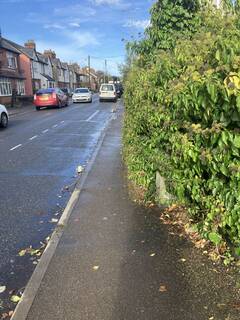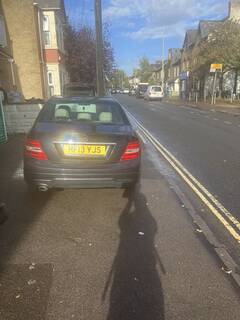There is a consultation on removing the parking on Hollow Way to reduce congestion, with reducing bus delays as the main motivation.
"There are longstanding issues on Hollow Way, where its narrow width coupled with on-street parking create congestion and a safety risk as there is not sufficient space for vehicles to easily pass one another. This is a particular issue for local bus services who regularly use the route and report regular delays. The issue also leads to traffic congestion and makes it more difficult for residents and businesses on the road."
But this illustrates how moto-normative transport planning still is, even in Oxford. The only gains considered are congestion reduction and safety for vehicles, which are balanced against the loss of parking for residents and businesses.
There is no mention of walking, wheeling or cycling, or of Vision Zero; nor are the broader effects on the lives of people considered. There is no discussion of traffic speed, though one of the central concerns with removing the parking is that it will result in people driving faster. And there is no mention of air pollution or noise pollution, which the scheme is likely to make better in some locations and worse in others.
The current situation on this stretch of Hollow Way is not good. It is hostile for people walking and wheeling, either along or across the road, and so hostile for cycling that it is one of the big holes in Oxford's accessible cycling network. This scheme should be used as an opportunity to address some of these problems, or at least designed to avoid making them worse.
The footways are already too narrow for pedestrian comfort or indeed safety. On the side of the road where parking is being removed, people walking and wheeling will lose the short stretches of protection provided by parked cars; on the other side of the road, vehicles will be warier of oncoming vehicles than parked ones, and so will drive closer to the kerb and people walking or wheeling on it. And higher vehicle speeds will create other problems, perhaps most obviously with crossing either Hollow Way or the side streets.
Removing the parking is likely to make it harder to cross Hollow Way away from the signal crossing. It may alleviate risks created by parked vehicles blocking visibility, but at the expense of increasing the effective crossing distance. And the current alternating streams of traffic leave gaps long enough for crossing in reasonable comfort; it is likely to be harder to find a gap to cross in steadier streams of two-way traffic. (Note that this also affects people cycling across Hollow Way, especially between Salegate Lane and Fern Hill Rd and between Crescent and Marshall Roads, both of which are LCWIP cycling routes.)
This scheme would bring overall gains for cycling. Currently parked cars block visibility, force people cycling to merge with motor traffic, pose a danger when pulling into or out of parking spaces, and create dooring risks; and some drivers don't treat cycles as full participants in the directional alternation. But faster moving motor traffic would both increase danger directly and make close-passes more likely — the faster people are driving, the more likely they are to force an overtake rather than wait behind someone cycling.
The parking removal is likely to reduce the queues at the current pinch points, at the expense of longer peak hour queues at the B480 traffic lights. The queues at the Horspath Rd junction are likely to clear each cycle, even in peak hour. So it will mostly reduce peak hour delays to northbound cars and buses and "shoulder" delays in both directions.
Most of the homes along this stretch of Hollow Way have only very small front yards, which combined with the narrow footways results in very short setbacks from the carriageway. This exacerbates both noise and air pollution. The parking removal could reduce both air and noise pollution, by reducing stop-start movements and accompanying acceleration and decceleration, resulting in smoother and steadier traffic, and by reducing the time vehicles spend queueing on this stretch of road. However if traffic speeds increase, that will offset these gains, especially with noise pollution.
Recommendations
If the parking is removed, measures need to be taken to keep vehicle speeds low. I suggest narrowing the carriageway on this stretch to a uniform 6m metres, with any space freed up used to widen the footways. The narrower carriageway would keep speeds lower and discourage drivers from overtaking people cycling, and even slightly wider footways - say 1.4m instead of 1.2m - would significantly improve the walking and wheeling experience. (The narrowest stretch of carriageway is just over 6m wide, but there is considerable variation.) This could perhaps be done relatively cheaply with bolt-down rubber kerbs, backfilled to the existing kerbs.
Measures should also be taken to trim vegetation and if possible relocate the most problematic pieces of street furniture. Parking enforcement should be requested to take action against vehicles parked off-road but partly on the footway.
Other measures could include a new zebra crossing between Marshall and Crescent Rds, to support use of the bus stops there and pedestrian routes to Crescent Rd. The signal crossing at Fern Hill Rd could be converted to a zebra crossing: this will help to slow motor traffic, but will also avoid pedestrians waiting to cross blocking the narrow footways. Continuous footways (Side Road Entry Treatments) should be put across all the side streets (though the highest priorities here are probably Barracks Lane and Horspath Rd).
Even with the traffic filters the traffic volumes here will remain too high for cycling with motor traffic to be inclusively accessible, but there simply isn't enough space for provision of cycling infrastructure. As a "best possible" measure, large cycle symbols should be painted in the middle of the carriageway, in both directions, as on the narrow stretch of the B480 and on similar sections of road elsewhere in Oxford. (The Temple Rd + Crescent Rd low traffic route allows bypassing some of the constrained area, but no such route exists to the east.)
The loading restrictions should start at 2.30pm in the afternoon, to inhibit parking by parents picking up children from nearby schools.
In the longer-term, the key is reducing traffic volumes. The planned traffic filter will reduce motor traffic on this stretch of Hollow Way, which will alleviate some of the problems but remove none of them — the road layout will still encourage speeding; the footways will still be too narrow there will still be too much motor traffic for inclusive cycling; the setbacks to homes will not be any bigger; and so forth. So in the longer-term, consideration should be given to putting a proper bus gate on Hollow Way, making this stretch of road into a low traffic neighbourhood.



Agree with all your improvement ls for pedestrians but disappointed that there is so little for cyclists. Clearly I have to accept that the road is too narrow but couldn't more be done to slow traffic down?
The Holloway / Horspath Driftway roundabout badly needs to be made safer for cyclists if the parking is removed
It's already so dangerous that we, and the school kids, avoid using it. We use a sneaky cut through the estate instead.
Sadly I can't see any way to fit cycling infrastructure in. As you can see we need to trim the carriageway to a bare minimum just to fit in adequate footways. (It might be possible to get a cycle lane on the approach to the B480, where there's more width.)
So for cycling we have to make do with 1) getting motor traffic as low as possible and 2) keeping speeds as low as possible.